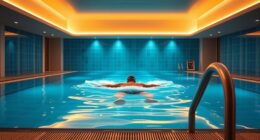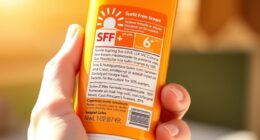To enjoy safe tanning around water, always apply a broad-spectrum sunscreen with SPF 30+ generously 15 minutes before sun exposure and reapply every two hours, especially after swimming or toweling off. Stay hydrated by sipping water regularly, and watch for signs of dehydration. Protect your skin from burns and long-term damage by balancing sunbathing with proper water intake and sun safety practices. Keep these tips in mind to make your poolside experience both enjoyable and safe.
Key Takeaways
- Apply broad-spectrum SPF 30+ sunscreen generously 15 minutes before sun exposure and reapply every two hours, especially after swimming or sweating.
- Keep a refillable water bottle nearby and sip frequently to stay hydrated and prevent dehydration-related skin damage.
- Reapply sunscreen immediately after water contact or towel-drying to maintain effective sun protection.
- Cover all exposed skin, including ears, neck, and tops of feet, for comprehensive sun safety during poolside lounging.
- Recognize dehydration signs like dizziness and fatigue, and prioritize hydration to support skin health and safe tanning.

Spending time poolside often means catching some sun and achieving that perfect tan, but it’s important to be mindful of your habits to protect your skin and stay healthy. One of the most essential steps is proper sunscreen application. You want to apply a broad-spectrum sunscreen with at least SPF 30 generously over all exposed skin about 15 minutes before you hit the water or sun. Don’t forget commonly missed spots like behind your ears, your neck, and the tops of your feet. Reapply every two hours, or more often if you’re swimming or sweating. Water can reflect sunlight and intensify UV exposure, so even if you’re in the shade, your skin still needs protection. Using a water-resistant sunscreen ensures your skin remains guarded during water activities. Remember, applying sunscreen isn’t a one-and-done task—make it part of your routine to reapply regularly to prevent burns and skin damage.
Alongside sunscreen use, hydration tips are just as essential. Spending hours in the sun and water can cause dehydration quickly. Keep a large, refillable water bottle nearby and sip frequently, even if you don’t feel thirsty. Dehydration can lead to fatigue, dizziness, and dry skin, undermining your poolside experience. To boost hydration, you might also enjoy drinks with electrolytes, especially if you’re active or sweating a lot. Fresh fruit infused water is a tasty alternative that offers hydration along with some nutrients. Avoid excessive alcohol, which can dehydrate you further and impair your judgment regarding sun safety. Staying well-hydrated helps your body regulate temperature and keeps your skin supple and healthy, which is indispensable when you’re lying out in the sun. Additionally, understanding UV exposure and its effects can help you make more informed decisions about sun safety.
It’s easy to get caught up in relaxing by the water, but taking these simple steps can make a big difference. Prioritize applying sunscreen properly, making sure every inch of your skin is protected before you start sunbathing. Set reminders to reapply, especially after swimming or towel-drying. Also, keep hydration at the forefront of your mind by drinking water regularly and paying attention to signs of dehydration like dry mouth or feeling lightheaded. These habits not only help you avoid painful sunburns and long-term skin damage but also ensure you enjoy your poolside time to the fullest. Protecting your skin and staying hydrated are indispensable parts of a safe, enjoyable poolside lifestyle, so make them a priority every time you lounge by the water.
Frequently Asked Questions
How Often Should I Reapply Sunscreen When Tanning Near Water?
You should reapply sunscreen every two hours during your tanning session, especially near water where reflections increase UV exposure. If you’re swimming or sweating, reapply more frequently, ideally immediately after water activities. Keep in mind that the longer your tanning session lasts, the more often you need to reapply sunscreen to maintain protection. Don’t forget to generously cover all exposed skin to prevent sun damage.
Can Water Reflection Increase My Risk of Sunburn?
Water reflection can definitely increase your risk of sunburn because it intensifies UV rays exposure. When you’re near water, the reflected sunlight hits your skin from multiple angles, boosting UV radiation. This means even if you’re in the shade or wearing sunscreen, the reflected light still poses a risk factor. To protect yourself, reapply sunscreen frequently, wear protective clothing, and seek shade when possible to minimize your risk of sunburn.
Are There Specific Clothing Options for Safer Water Tanning?
Sure, waterproof fabrics and UPF clothing are your best bets for safer water tanning. Ironically, while you might think waterproof clothes keep you dry, they actually protect your skin from UV rays, reducing burn risk. Look for UPF-rated garments that block out harmful rays. Wearing these, you’ll enjoy your time poolside and protect your skin, proving that sometimes, the best summer gear is about staying safe while having fun.
How Does Water Temperature Affect Tanning Safety?
Water temperature affects your tanning safety by influencing water conductivity and temperature regulation. When the water’s warm, your body temperature rises faster, increasing dehydration risk and skin damage. Cooler water helps regulate your body temperature, reducing these risks. Always pay attention to water temperature, stay hydrated, and take breaks in the shade. This way, you protect your skin while enjoying your time around water.
What Are Signs of Early Sunburn or Skin Damage?
If you notice skin redness or peeling signs, you’re experiencing early sunburn or skin damage. These symptoms appear shortly after overexposure to UV rays and indicate that your skin needs immediate care. Pay attention to any discomfort or hot feeling on your skin, as these are also signs of early damage. To protect yourself, remove yourself from the sun, hydrate, and apply soothing aloe vera or moisturizer.
Conclusion
Enjoying the sun by the water feels relaxing, but remember, safety should never take a backseat. While the shimmering pool invites you to relax and soak up rays, neglecting protection can turn your peaceful day into a painful or dangerous experience. Protect your skin, stay hydrated, and take breaks in the shade. Because the true luxury isn’t just looking good—it’s feeling safe and healthy, even amidst the allure of a perfect poolside day.









